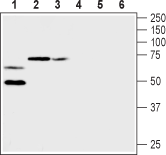Overview
- Peptide (C)RDENEDMHGGGVT, corresponding to amino acid residues 189-201 of rat KV1.2 (Accession P63142). 1st extracellular loop.

 Western blot analysis of rat heart membranes (lanes 1 and 4), mouse brain membranes (lanes 2 and 5) and rat brain membranes (lanes 3 and 6):1-3. Anti-KV1.2 (KCNA2) (extracellular) Antibody (#APC-162), (1:200).
Western blot analysis of rat heart membranes (lanes 1 and 4), mouse brain membranes (lanes 2 and 5) and rat brain membranes (lanes 3 and 6):1-3. Anti-KV1.2 (KCNA2) (extracellular) Antibody (#APC-162), (1:200).
4-6. Anti-KV1.2 (KCNA2) (extracellular) Antibody, preincubated with Kv1.2/KCNA2 (extracellular) Blocking Peptide (#BLP-PC162).
 Expression of KV1.2 in live intact rat PC12 cellsCell surface detection of KV1.2 in live intact rat PC12 pheochromocytoma cells. A. Extracellular staining of cells with Anti-KV1.2 (KCNA2) (extracellular) Antibody (#APC-162), (1:50), followed by goat anti-rabbit-AlexaFluor-488 secondary antibody (green). B. Live view of the cells. C. Merge of A and B.
Expression of KV1.2 in live intact rat PC12 cellsCell surface detection of KV1.2 in live intact rat PC12 pheochromocytoma cells. A. Extracellular staining of cells with Anti-KV1.2 (KCNA2) (extracellular) Antibody (#APC-162), (1:50), followed by goat anti-rabbit-AlexaFluor-488 secondary antibody (green). B. Live view of the cells. C. Merge of A and B.
- McKinnon, D. (1989) J.Biol. Chem. 264, 8230.
- Gutman, G.A. et al. (2005) Pharmacol. Rev. 57, 473.
- Long, S.B. et al. (2005) Science 309, 897.
- Bogin, O. (2006) Modulator 21, 28.
KV1.2 is a mammalian voltage-dependent K+ channel, homologous to the Drosophila Shaker K+ channel. KV1.2 was first cloned from rat brain.1 Eight Shaker-related genes exist in mammals constituting the KV1 subfamily of the large KV channel family of genes.2
A functional KV1 channel is either a membrane spanning homotetramer or heterotetramer, which is composed of members of the same subfamily. In addition several auxiliary subunits and intracellular proteins might interact with the channel and affect its function.
The structure of KV1.2 channel is similar to all KV channels and includes six membrane spanning helices creating a voltage sensor domain and a pore domain.2
The channel is expressed in neurons and cardiac and smooth muscle tissue as well as in retina and pancreas.2 The crystal structure of KV1.2 was recently solved shading light on the structure of a mammalian voltage dependent channel.3 The functional channel is considered low voltage activated and shows very little inactivation. Therefore, this channel activity influences the membrane potential and excitability of neurons and muscle.
KV1.2 channels are sensitive to high doses of TEA (560 mM) and low doses of 4-AP (0.59 mM), the “classical” non-selective potassium channel blockers.
Several venomous toxins from snakes, scorpions and honey bee are potent blockers (affecting the channels in the nanomolar range) of KV1.2 channels. Among these, the most potent and selective are α-Dendrotoxin (1-12 nM), Dendrotoxin-I (0.13 nM), Maurotoxin (0.1-0.8 nM), Hongotoxin-1 (0.17 nM), Margatoxin (0.16-0.65 nM), Tityustoxin Kα (0.21 nM) and MCD peptide (10-400 nM).4
Application key:
Species reactivity key:
Alomone Labs is pleased to offer a highly specific antibody directed against an epitope of rat KV1.2. Anti-KV1.2 (KCNA2) (extracellular) Antibody (#APC-162) can be used in western blot and live cell imaging applications. It has been designed to recognize KV1.2 from human, rat and mouse samples.
